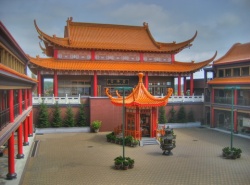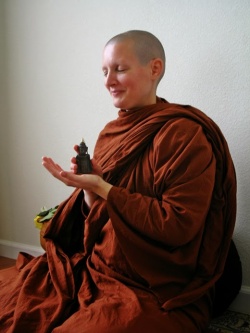Precedent from Early Arahants on the Bestowal of Bhikkhuni Ordination
by Ayya Tathāloka
Written in commemoration of the lunar anniversary of our Venerable Foremother Saṅghamittā Therī’s arrival on Lankadvipa twenty-three centuries ago, as an inquiry into the ordination practices of our early arahant forebears, particularly those great Dhamma emissaries who spread the Buddha's teaching beyond the central heartland of the Indian Madhyadesa to foreign lands, far and wide in all directions.
Great Activities of Early Arahants
We have heard and read that in the early days of the Buddha sāsana, while the Blessed One still lived and breathed and walked the dusty paths of India's ancient heartland, there were many fully enlightened women, bhikkhunī arahants. The Buddha’s beloved former wife , his foster mother, his half-sister, and many more Sakyan daughters were amongst the ladies of the Madhyadesa who became the Blessed One's foremost disciples, preeminent in all good qualities and virtues.
When the Sakyan ladies emerged en masse from their native home, Kapila—on foot, hair shorn, bereft of all but the humble robes of samaṇas, it was the Blessed One who received them and ordained his foster mother—she already attained to the first stages of sainthood. And to his bhikkhu saṇghā he gave the honor and responsibility of bestowing ordination upon the many saintly and aspiring others, uplifting five hundred more of these daughters of the Sakyans into full communion in the monastic saṇghā. Thus the bhikkhunī sāsana arose in the world in this fortunate eon, although there are rumors of other early solitary wanderers amongst women, quick to be enlightened, called directly to the path by the Conqueror.
Not long after, in praise of the effectiveness of his teaching, the Blessed One, the noble Lord Buddha himself testified to the attainment in his twofold monastic saṇghā—the complete enlightenment of five hundred of his monastic women disciples to the noble reaches and heights of the path, to arahant.
But then there were more . . .
For among the women elders, the therīs, there arose those who excelled in leadership and teaching: Therīs Khemā and Uppalavaṇṇā, preeminent in leadership of the women's monastic saṇghā; Therī Dhammadinnā for her buddhavacana , her words likened by the Blessed One to his own; and Therī Paṭācārā, preeminent in her deep knowledge and teaching of the monastic discipline of the Vinaya. It is said that the Venerable Paṭācārā herself had five hundred enlightened disciples, and likewise former queen, Anojā Therī, and the great therī Mahāpajāpatī Gotamī too, together with thousands following the Therī Bimba Yasodhara, unequaled in vision of the ages.
But those were the early days of the sāsana, when arahants flourished upon the lands of Middle Earth and the noble path of the ariyas and the banner of the arahants blazed forth in all their glory in robed feminine and masculine form. But you may ask, what of the arahants of later days, after the light of the Tathāgata passed from the world into the great and final bliss of parinibbāna?
The years passed and the Dhamma spread, then a great king emerged, who by bloody conquest terrorized and took for his own land after land, amassing an empire previously unknown until, upon seeing a gentle monastic recluse, Asoka the Black stopped, transformed, and became Asoka the Benevolent.
wo hundred and six years had passed between the Blessed One's parinibbāna and the birth of Asoka's noble daughter, the great lady, Saṅghamittā, later remembered as the wise one. Upon this noble daughter reaching the age of eighteen, 96,000 bhikkhunīs, the majority of them holy ones, converged upon the beautiful capitol city of the realm, Pāṭaliputta, together with six kotis [600,000] of holy bhikkhus for the dedication of 84,000 monasteries and reliquary stupas across the land, as called together by Saṅghamittā’s father, now Dhamma-Asoka, the great king, uniter of the continent. To fulfill his wish that he become a true relative of the sāsana by gift of his own flesh and blood, with her father's blessing Saṅghamittā too went forth and received the pabbajjā ordination from her preceptor, Dhammapālā Therī, with Ayupālā Therī as her teacher. She undertook the preliminary sikkhā training and then the full training; no long time passed before she joined these noble therīs in destroying the fetter of individual existence, entering and then fulfilling the arahant path.
Her blessed brother Mahinda also went forth and awoke, and after the passing of a decade, joined with other excellent messengers of the Dhamma who went far and wide to foreign lands, sharing the word of the Blessed One's noble and liberating doctrine, enlightening the multitudes everywhere. For the Blessed One told the bhikkhus "Go forth for the weal and welfare of the manyfolk, . . .” There are those with little dust in their eyes, . . .” and “the gates to the Deathless are open."
Then Mahinda called for Saṅghamittā. Her brother, this great thera, noble Mahinda, sent word by messenger from that lamp of an island Sri Lanka, far to the south where he had traveled teaching. For there Anulā Devi, queen of the king's noble brother, together with five hundred of her retinue of royal virgin companions, assembled and while listening to the Discourse on the Noble Truths, the Saccasaṃyutta, attained sotāpanna, entering that most noble of all streams, opening the Dhamma eye, gaining the vision of nibbāna. Then Anulā Devi, telling her king, Tissa, beloved of the devas, "Lord, I would go forth," she made known the inclination of her heart to renunciation and faithful as he was to the doctrine, the king in turn told this to his teacher, the noble thera Mahinda. For this, the great thera Mahinda called for the great therī Saṅghamittā, making it known, "It is not for a bhikkhu to do, when there are bhikkhunīs such as this sister of mine, noble and enlightened, friend of the saṇghā, Saṅghamittā. May she come here."
Then the king directed that an upāsikā vihāra be built for Queen Anula and the saintly ladies, noble in birth and noble in Dhamma vision that they could live at ease with the dasasila ten precepts and await Saṅghamittā who would ordain them.
Although reluctant that his daughter, the Venerable Lady Sanghamitta should leave his land too, faithful in his dedication, Dhamma-Asoka, lord of the continent, then made ready for her both ship and company As the thera Mahinda had named them, the wise theri Saṅghamittā’s companions, the noble ones: Uttarā, Hemā, Pasadapala (Masagalla ), Aggimittā, Dasika , Phegu (Tappa), Pabbata [-cchinna],Mattā, Mallā, and Dhammadasiya, bhikkhunīs free from desire and firm, with pure thoughts and wishes, firmly established in Dhamma and Vinaya, their passions subdued, with senses under control, attained to the three knowledges and supernormal powers, and well grounded in the highest bliss.
With sapling of the winter blossom-covered bodhi, southern branch of the fair and sacred fig under which the Blessed One awoke, Saṅghamittā came with her bhikkhunī retinue across the land and across the sea, blessed and accompanied by both devas and nāgas, calming storms, subduing the wilds of the ocean until they could see the shore and the Lankan king, beloved of the devas, waist-deep in the waters, hands held high in reverence above his head in welcome and exhalted joy. It was the first moon of the cool season when they descended, came ashore, and then up and into Anurādhapura, that most beautiful and beloved city, with streets clean swept in anticipation, strewn with rain of flowers showered down by devas.
The five hundred virgins surrounding Anulā and five hundred palace women, all free from passion and steadfast, received the pabbajjā ordination from the great therī, not long after fulfilling the arahant path in the illustrious doctrine of the Conqueror. And from them arose a great history, the Chronicle of the Lamp, and a great tradition of excellence in enlightenment, long-lasting, undying, to this day.
Ayyā Tathālokā Bhikkhunī Therī
Ayyā Tathālokā Bhikkhunī is an American-born member of the Buddhist Monastic Saṇgha with a background in Zen and Theravāda Buddhism. Venerable Tathālokā began her journey into monastic life nearly twenty-five years ago, and in 1997 was granted Higher Ordination by a multi-ethnic gathering of the Bhikkhu and Bhikkhunī Saṇghas in Southern California. In 2005 she co-founded the North American Bhikkhunī Association and the Dhammadharini Support Foundation. She is recipient of the 2006 Outstanding Women in Buddhism Award, and a presenting scholar at the 2007 International Congress on Buddhist Women's Role in the Saṇgha.
Following in the late Ayya Khemā's footsteps, Ayyā Tathālokā became the second Western woman in Theravāda Buddhism to be appointed bhikkhunī preceptor, serving in the going forth, training, and full ordination of women in Australia, the USA, and Thailand. In 2009 she served as preceptor for the historically significant bhikkhunī ordinations in Perth, Australia. She participated as preceptor in the bhikkhunī ordination ceremonies in Northern California at Aranya Bodhi Hermitage in 2010, Spirit Rock Meditation Center in Marin in 2011, and the American Buddhist Seminary Temple in Sacramento in 2012.
Inspired by the forest traditions in Buddhism, for the past five years she has been involved in developing a rustic, green, off-the-grid women's monastic retreat named Aranya Bodhi: Awakening Forest Hermitage, located on the Sonoma coast. She also writes on the history of women and Buddhism and Buddhist women's monastic discipline—two of her special areas of interest and research—in addition to teaching liberating Dhamma and meditation.


